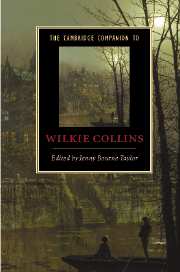Book contents
- Frontmatter
- Introduction
- 1 Collins’s career and the visual arts
- 2 The early writing
- 3 Collins’s shorter fiction
- 4 Collins and the sensation novel
- 5 The Moonstone, detective fiction and forensic science
- 6 The later novels
- 7 The professional writer and the literary marketplace
- 8 The marriage plot and its alternatives
- 9 Collins and Victorian masculinity
- 10 Collins and empire
- 11 Disability and difference
- 12 Collins and the theatre
- 13 The afterlife of Wilkie Collins
- Further reading
- Index
- Series List
7 - The professional writer and the literary marketplace
Published online by Cambridge University Press: 28 January 2007
- Frontmatter
- Introduction
- 1 Collins’s career and the visual arts
- 2 The early writing
- 3 Collins’s shorter fiction
- 4 Collins and the sensation novel
- 5 The Moonstone, detective fiction and forensic science
- 6 The later novels
- 7 The professional writer and the literary marketplace
- 8 The marriage plot and its alternatives
- 9 Collins and Victorian masculinity
- 10 Collins and empire
- 11 Disability and difference
- 12 Collins and the theatre
- 13 The afterlife of Wilkie Collins
- Further reading
- Index
- Series List
Summary
The defining moment of Wilkie Collins's career occurred at the turn of the 1860s with the runaway success of The Woman in White. The novel's striking combination of respectable settings and illicit events launched the fashion for 'sensation fiction' which prevailed through much of the next two decades, thus marking a breakthrough in the marketing of fiction as a commodity form. Running as a serial in Charles Dickens's new family weekly All the Year Round from November 1859, the narrative aroused wide interest with its eerily enigmatic opening and deft manipulation of suspense, causing queues on publication day and raising the circulation into six figures. When the novel appeared from Sampson Low in three volumes for the lending libraries in mid-August 1860, it was widely advertised, sold 1,350 copies within the week and received its eighth impression before the end of the year. When the single-volume edition appeared from the same publisher in April 1861, embellished with a signed likeness of the author, Collins had to sit several times for the photographer to keep pace with the demand.
- Type
- Chapter
- Information
- The Cambridge Companion to Wilkie Collins , pp. 97 - 111Publisher: Cambridge University PressPrint publication year: 2006
- 2
- Cited by

